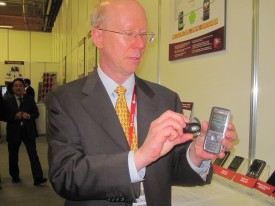Interview: Broadcom CEO Touts Gains in Low-End Android Market
When big-name phone makers announce a new high-end phone, they often tout the fact that it is powered by a chip from Qualcomm, Nvidia or Texas Instruments.
Those aren’t the only players, though. Samsung and Huawei make some of their own chips, while Intel is also going after this market. Quietly making inroads as well is Broadcom.
The Orange County, Calif., chipmaker has long made Bluetooth, Wi-Fi and other communications chips for phones. In recent months, though, it has been able to capture a sizeable chunk of the main processor market, thanks to its chip, which combines an application processor with another key component, the communications baseband.
“Smartphones have become a significant business for Broadcom,” Broadcom CEO Scott McGregor told AllThingsD in an interview last week.
McGregor declined to get specific, but a recent J.P. Morgan report estimated that Broadcom’s baseband and application processor is now in roughly a third of Samsung’s smartphones, which it says represents three to four times what the company was doing as recently as the second half of this year.
Among the models using Broadcom’s chips are the Galaxy Y, Galaxy Mini and Galaxy Ace, J.P. Morgan said, projecting sales of about 12 million to 13 million phones per quarter, which it says could translate into $500 million in annual revenue.
Broadcom, it notes, also has about 70 percent share with most of the major smartphone and tablet makers for the chips needed to do Wi-Fi, Bluetooth and GPS. The new iPad, for example, uses Broadcom’s chips, according to an IHS iSuppli teardown of the tablet.
“Over the next few years, Broadcom should emerge as one of the top players in the mobile/cellular semiconductor market,” J.P. Morgan’s analysts said in their report.
Wedge Partners analyst Brian Blair said he left last month’s Mobile World Congress in Barcelona even more positive than he had been on Broadcom’s prospects.
“We have said that we believe that the biggest trend of the decade is the low-end smartphone,” Blair said in a research note. “One of the most surprising elements of this trend is how good the entry level models have become, and one of the reasons for this is Broadcom.”
Blair said that even phones that sell for $150 unsubsidized are now capable of doing what a high-end smartphone did just two years ago. The phones powered typically have a 1GHz processor and baseband and other communications and power management chips, all of which can add up to devices with $20 to $22 worth of Broadcom silicon, assuming it has all of its chips inside.
Historically, the chipmaker has mainly gone after the midrange of the market, but McGregor promised that the company will move into higher-end devices this year, as well as a bit down-market.
“We’ll cover the whole waterfront,” McGregor said. He acknowledged that the company had some catching up to do in application processors and high-end modems, such as those used in 4G phones.
Android has grown considerably, he said, though he still sees some room for other operating systems, particularly now the Microsoft has managed to get several phone makers to pay a royalty on every Android device they sell.
“One of the challenges of Android is that Microsoft is now hitting up all of the handset makers and claiming a corkage free on that dinner,” McGregor said. “I think that’s an interesting challenge for the handset industry.”










